壳聚糖ppt
- 格式:pptx
- 大小:243.01 KB
- 文档页数:35

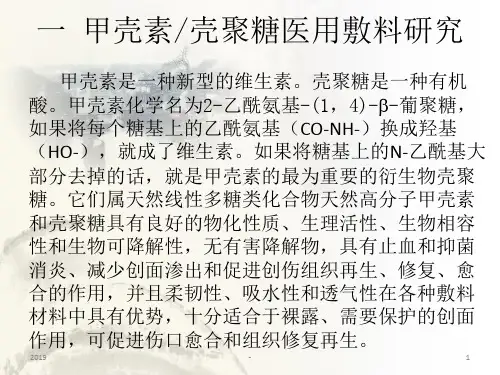
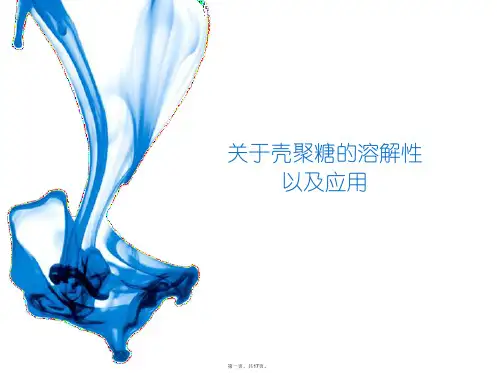

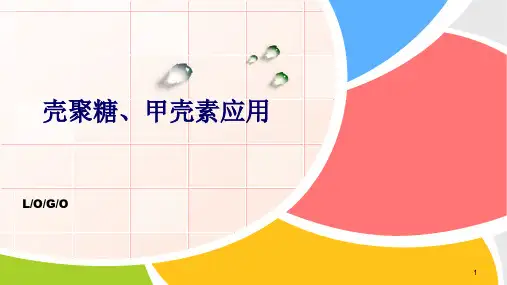


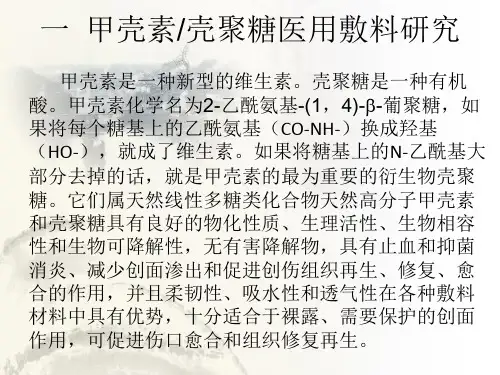


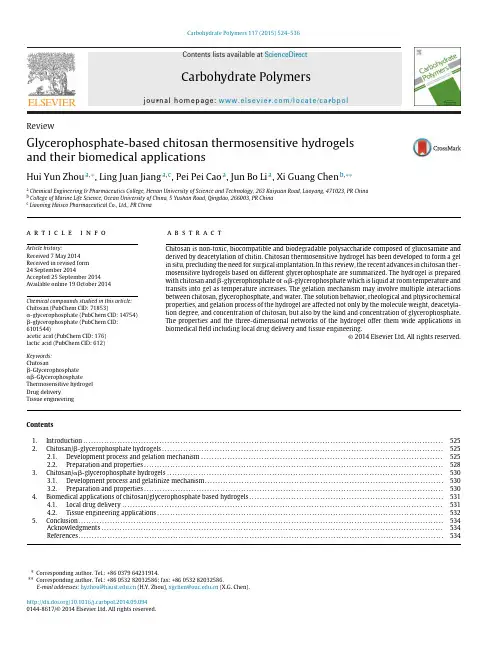
Carbohydrate Polymers 117(2015)524–536Contents lists available at ScienceDirectCarbohydratePolymersj o u r n a l h o m e p a g e :w w w.e l s e v i e r.c o m /l o c a t e /c a r b p olReviewGlycerophosphate-based chitosan thermosensitive hydrogels and their biomedical applicationsHui Yun Zhou a ,∗,Ling Juan Jiang a ,c ,Pei Pei Cao a ,Jun Bo Li a ,Xi Guang Chen b ,∗∗aChemical Engineering &Pharmaceutics College,Henan University of Science and Technology,263Kaiyuan Road,Luoyang,471023,PR China bCollege of Marine Life Science,Ocean University of China,5Yushan Road,Qingdao,266003,PR China cLiaoning Haisco Pharmaceutical Co.,Ltd.,PR Chinaa r t i c l ei n f oArticle history:Received 7May 2014Received in revised form 24September 2014Accepted 25September 2014Available online 19October 2014Chemical compounds studied in this article:Chitosan (PubChem CID:71853)␣-glycerophosphate (PubChem CID:14754)-glycerophosphate (PubChem CID:6101544)acetic acid (PubChem CID:176)lactic acid (PubChem CID:612)Keywords:Chitosan-Glycerophosphate ␣-Glycerophosphate Thermosensitive hydrogel Drug deliveryTissue engineeringa b s t r a c tChitosan is non-toxic,biocompatible and biodegradable polysaccharide composed of glucosamine and derived by deacetylation of chitin.Chitosan thermosensitive hydrogel has been developed to form a gel in situ,precluding the need for surgical implantation.In this review,the recent advances in chitosan ther-mosensitive hydrogels based on different glycerophosphate are summarized.The hydrogel is prepared with chitosan and -glycerophosphate or ␣-glycerophosphate which is liquid at room temperature and transits into gel as temperature increases.The gelation mechanism may involve multiple interactions between chitosan,glycerophosphate,and water.The solution behavior,rheological and physicochemical properties,and gelation process of the hydrogel are affected not only by the molecule weight,deacetyla-tion degree,and concentration of chitosan,but also by the kind and concentration of glycerophosphate.The properties and the three-dimensional networks of the hydrogel offer them wide applications in biomedical field including local drug delivery and tissue engineering.©2014Elsevier Ltd.All rights reserved.Contents 1.Introduction .........................................................................................................................................5252.Chitosan/-glycerophosphate hydrogels ...........................................................................................................5252.1.Development process and gelation mechanism ............................................................................................5252.2.Preparation and properties ..................................................................................................................5283.Chitosan/␣-glycerophosphate hydrogels .........................................................................................................5303.1.Development process and gelatinize mechanism...........................................................................................5303.2.Preparation and properties ..................................................................................................................5304.Biomedical applications of chitosan/glycerophosphate based hydrogels ..........................................................................5314.1.Local drug delivery ..........................................................................................................................5314.2.Tissue engineering applications .............................................................................................................5325.Conclusion ...........................................................................................................................................534Acknowledgments ..................................................................................................................................534References ...........................................................................................................................................534∗Corresponding author.Tel.:+86037964231914.∗∗Corresponding author.Tel.:+86053282032586;fax:+86053282032586.E-mail addresses:hyzhou@ (H.Y.Zhou),xgchen@ (X.G.Chen)./10.1016/j.carbpol.2014.09.0940144-8617/©2014Elsevier Ltd.All rights reserved.H.Y.Zhou et al./Carbohydrate Polymers117(2015)524–5365251.IntroductionHydrogels are composed of three-dimensional polymer networks that have a high number of hydrophilic groups.The hydrogels can absorb large quantities of water and will neither disintegrate nor dissolve.Fully swollen hydrogels are soft,pliable, and low interfacial tension with water or biologicalfluids.The high water content of hydrogel renders it compatible with most living tissue and the viscoelastic nature of hydrogel minimizes damage to the surrounding tissue when it is implanted in the host.These characteristics make hydrogel an ideal candidate in biomedical applications such as remedying injuries to living sys-tems(Bhattarai,Gunn,&Zhang,2010).In addition,hydrogels can serve as a supporting material for cells during tissue regeneration as well as drug delivery system because the hydrogel’s physico-chemical properties are similar to the native extracellular matrix both compositionally and mechanically(Lee&Mooney,2001; Tessmar&Gopferich,2007).The hydrogel will become responsive to environmental stimulation if the polymer network of hydrogel is endowed with functional groups(Buenger,Topuz,&Groll,2012). The stimulation may be temperature,pH,biomolecules,electric field,magneticfield,light rays and so on.When the environment stimulation is changed,the hydrogels undergo a volume-phase transition due to molecular interactions resulting in abrupt changes in the network such as swelling,collapse or sol-to-gel transition.Glycerophosphate is an organic compound naturally found in the body which is usually used as a source of phosphate in the treatment of unbalance of phosphate metabolism and its veinal administration has been approved by FDA.-Glycerophosphate has been shown as an osteogenic supplement when added to cultures of human bone marrow stem cells.␣-Glycerophosphate is the mixture of␣-glycerophosphate and-glycerophosphate,and␣-glycerophosphate has linear chain structure and shows less steric hindrance than-glycerophosphate.Glycerophosphate also has been used as a catalyst to cause a sol-to-gel transition in chitosan solutions at physiological pH and temperature.Chitosan,the cationic(1-4)-2-amino-2-deoxy--D-glucan, partly acetylated to the typical extent close to0.25is industrially produced in medical/pharmaceutical grade from marine chitin (Jayakumar,Menon,Manzoor,Nair,&Tamura,2010;Jayakumar, Prabaharan,Nair,&Tamura,2010;Jayakumar et al.,2010; Muzzarelli,2009;Muzzarelli,2010;Muzzarelli,2012;Muzzarelli et al.,2012).The development of chitosan hydrogel has been an area drawing intensive investigation and a large amount of works have been reported on chitosan hydrogel and its potential use in various applications(Lee et al.,2009;Nagahama et al.,2009;Sung et al.,2010;Tang,Du,Hu,Shi,&Kennedy,2007;Zhou et al.,2012).Chitosan hydrogels have been prepared with a variety of differ-ent geometries and formulations including liquid gels,beads,films, tablets,capsules,microspheres,microparticles,sponges,and textile fibers(Denkbas,2006;Hamidi,Azadi,&Rafiei,2008;Khan,Tare, Oreffo,&Bradley,2009;Ladet,David,&Domard,2008).In each preparation,the polymer binding is accomplished either by non-covalent physical association,such as secondary forces(hydrogen, ionic,or hydrophobic bonding)and physical entanglements,or by covalent cross-linked chemical association(Hoffman,2002).Physi-cal associated networks can often be obtained by simply mixing the components which make up the gel under the appropriate condi-tions.Furthermore,the gelation,requiring no toxic covalent linker molecules,is always safe for clinical applications.This review focuses on the hydrogel based on different glycerophosphate including the preparation and applications, which is a temperature-sensitive physical associated network. There are several excellent reviews of hydrogel or chitosan-based hydrogel(Bhattarai et al.,2010;Buenger et al.,2012; Hoffman,2002;Lee&Mooney,2001)and there is a review about thermosensitive chitosan/glycerophosphate-based hydrogel and its derivatives(Supper et al.,2014),but an in-depth review on chitosan/glycerophosphate hydrogel based on the different glyc-erophosphate cannot be found ever.In this review,we will summarize the various categories of chitosan/glycerophosphate hydrogels prepared with chitosan and-glycerophosphate or␣-glycerophosphate,describe the preparation methods,introduce the properties and gelation mechanism,and present recent advances in biomedical applications.2.Chitosan/-glycerophosphate hydrogels2.1.Development process and gelation mechanismChitosan dissolves in acidic environments via protonation of its amine groups.Once dissolved,chitosan remains in solution up to pH value in the vicinity of6.2.Neutralization of chitosan aqueous solutions to pH value exceeding6.2systematically leads to the for-mation of a hydrated gel-like precipitate.Effort on chitosan neutral solution isfirst proposed by Chenite et al.(2000).Theyfind that chi-tosan solutions remain liquid below room temperature,even with pH values within a physiologically acceptable neutral range from 6.8to7.2,in the presence of-glycerophosphate salt.The system becomes thermally sensitive,which is liquid at room temperature and solidifies into gel as temperature increasing to body tempera-ture(Fig.1)(Ruel-Gariépy et al.,2004).-glycerophosphate plays three essential roles in the system:(1)to increase the pH into the physiological range of7.0–7.4;(2)to prevent immediate precip-itation or gelation;and(3)to allow for controlled gel formation when an increase in temperature is imposed.The sol-to-gel tran-sition temperature is pH-sensitive and gelling time is shown to be temperature-dependent.The molecular mechanism of gelation may involve multiple interactions between chitosan,-glycerophosphate,and water (Crompton et al.,2005;Ruel-Gariépy,Chaput,Guirguis,&Leroux, 2000).The effective interactions responsible for the sol/gel tran-sition included:(1)the increase of chitosan interchain hydrogen bonding as a consequence of the reduction of electrostatic repulsion due to the basic action of the salt,(2)the chitosan-glycerol-phosphate electrostatic attractions via the ammonium and the phosphate groups,respectively,and(3)the chitosan–chitosan hydrophobic interactions which should be enhanced by the struc-turing action of glycerol on water.The solution behavior of chitosan/-glycerophosphate hydro-gel is affected by the concentration of chitosan and-glycerophosphate(Cho,Heuzey,Bégin,&Carreau,2006a).The pH of chitosan solution is slightly increased with increasing of -glycerophosphate concentration due to the neutralizing effect of the phosphate groups.The pH increase with polymer concen-tration is due to the consumption of H+ions in solution by the protonation of the free amine groups.The relationship between gelation temperature and concentration of chitosan(C C)and-glycerophosphate(C GP)is shown in Fig.2.The region below the surface is the sol state,while that above is a gel.T gel is gradually decreased with increasing of C GP and C C.However,a synergetic effect at high C GP and C C results in a sudden drop of the gelation temperature and a phase transition which is on the edge between concentration-induced and heat-induced gelation.The rheological and physicochemical properties of the chitosan/-glycerophosphate system in terms of temperature are investigated sequentially(Chenite,Buschmann,Wang,Chaput, &Kandani,2001;Cho,AndréBégin,&Carreau,2005).Increasing temperature has no effect on the pH value of the chitosan/-glycerophosphate system,while conductivity is increased.The results indicate that the decrease of potential ionic interactions526H.Y.Zhou et al./Carbohydrate Polymers 117(2015)524–536Fig.1.The CS/GP formulation at room temperature (left)and at 37◦C (right).Figure was reprinted from Ruel-Gariépy et al.(2004).such as ionic bridging is resulted in by the reduction of the ratio of NH 3+in chitosan and OPO(O −)2in -glycerophosphate at high temperature.On the other hand,the favorable conditions for gel formation resulted in by the increased ionic strength as a function of temperature involved which enhanced screening of electrostatic repulsion forces and hence more polymer–polymer hydrophobic interactions.Since it is generally assumed that hydrogen bonding interactions are not predominant at high temperature and hydrophobic effect is the main driving force for the chitosan/-glycerophosphate gelation at high temperature.To expand this standpoint,physicochemical and rheological properties of the chitosan/-glycerophosphate system is inves-tigated in the presence of urea,which is a hydrogen bonding disrupting agent and can also affect hydrophobic interaction (Cho,Heuzey,Bégin,&Carreau,2006b ).Heat-induced gelation of the chitosan system in the presence of urea shows higher gelation temperature in nonisothermal tests and longer gelation time in isothermal conditions.At low temperature,urea strongly affects polymer–polymer interactions by weakening hydrogen bonds.With temperature increasing,it hinders hydrophobic effect since the reduction of ionic strength results in less screening of elec-trostatic repulsion between protonated glucosamine groups.It is confirmed that hydrophobic effect is the main driving force for the chitosan/-glycerophosphate heat-induced gelation.Aliaghaie,Mirzadeh,Dashtimoghadam,and Taranejoo (2012)have investigated the gelation mechanism of injectable thermosen-sitive hydrogels comprising chitosan and -glycerophosphate by rheological measurements for a drug delivery.According totheFig.2.Phase diagram for T gel under various -GP (C GP )and chitosan (C C )concen-trations.Figure was reprinted from Cho et al.(2006a).gelation behavior,three regions are defined:(1)a liquid-like behav-ior at low temperature,(2)a fast gelation process near the gel point,and (3)a slow gelation process at higher temperatures (seen in Fig.3).The theory initially worked out by Fredrickson and Larson for block copolymers near their order–disorder transition is extended and proposed to precisely determine the gel point in such systems by considering the aggregation of hydrophobic acetylated blocks of chitosan chains and gelation in chitosan/glycerophosphate systems as an order–disorder transition of block copolymers.Upon heat-ing,the water sheaths around chitosan chains are removed and the heat induced transfer of protons from protonated amino groups to glycerophosphate occurs,and consequently the formation of hydrophobic interactions among chitosan chains is facilitated.Then the gelation process beyond the crossover point goes through a nucleation and growth mechanism and the growth of hydrophobic domains could happen through the reaction limited cluster aggre-gation.In the third region,the observed rheological behavior could be associated with the tendency of system to minimize its interfa-cial area through the Ostwald ripening process.In addition,the effect of molecular weight and deacetylation degree of chitosan on gelation process is researched.The results of the temperature sweep measurement (Aliaghaie,Mirzadeh,Dashtimoghadam,&Taranejoo,2012)have been shown that the G and G crossover point for lower molecular weight chitosan sample have been shifted to 33◦C,which is 2◦C higher than that for high molecular weight chitosan sample.This implies that the hydropho-bic interactions in lower molecular weight chitosan sample have been formed at a higher temperature,which might be a result of lower entanglement and shorter hydrophobic domains.Such an observation could be attributed to the lower molecular weight and consequently lower viscosity of the sample,which provides more possibility for aggregation and percolation of hydrophobic domains through reaction limited cluster aggregation theory.ItFig.3.The evolution of the storage (G )and loss (G )moduli of the chitosan hydrogel during heating from 25to 65◦C.Figure was reprinted from Aliaghaie et al.(2012).H.Y.Zhou et al./Carbohydrate Polymers117(2015)524–536527 Table1Parameters,gel temperature and gel time of chitosan/glycerophosphate hydrogels:some examples..Chitosan C GP(w/v)T gel/◦C Gel time ReferenceMw/kD DD C(w/v)-GP␣-GP700/200–30074%/99%1%(1/1)23%31–33120–280s Aliaghaie et al.(2012) 35091%1–2%0–8%32–4213–2min Chenite et al.(2001)552–80870–91%2% 5.6%37–66quickly Chenite et al.(2000) 85093%0.05–0.20M0.33–0.83M58–797–11s Cho et al.(2006a,b)140cps96.5%0.1512–0.1728%2–8%30.1–45.71–3min Dang et al.(2011)140cps96.5%0.1512–0.162%5–8%21–3530–90s Dang et al.(2012a,b)463–86281.8–83.4% 2.05%9.09%371400–2400s Douglas et al.(2013)455.295%2% 5.6%,7%33,37/Hastings et al.(2012)20–525cps91%2%8%374–10min Huang et al.(2009) 108086%2%8.33–9.09%25–3720–3min Ji et al.(2010)/95% 2.5%6–16%50–37Kempe et al.(2008) 31075% 1.5%0.045–1.155M3760–330s Kim et al.(2010)200–800cps75–80% 1.6%30%37/Kwon et al.(2012)/75–85%0.9% 5.8%376min Niranjan et al.(2013)/95% 1.4–2.2%w/w8–16%w/w37/Peng et al.(2013a,b)421.8/455.284%/95% 1.5%w/w7.27%w/w7.27%w/w375/140min Ruel-Gariépy et al.(2000) 113–90065–88%2%2–8%24.3–91.7/Tsai et al.(2011)300–40081.0–94.8% 1.8%5%372–60min Zan et al.(2006)5095%2%10%376min Zhang et al.(2013) 136075% 1.7–1.9% 2.5–7.5%3710min Zhou et al.(2009)88–136056.5–90.3% 1.0–3.0%5%3710min Zhou et al.(2008)-GP:-glycerophosphate;␣-GP:␣-glycerophosphate;T gel:gel temperature.could be suggested that the lower molecular weight has facilitated the aggregation and percolation of hydrophobic domains,which is consistent with the lower percolation temperature obtained from temperature sweep measurements.Furthermore,it is under-stood that the deacetylation of chitin chains to achieve chitosan preferably occurs at the amorphous zones,and hence blocktype distribution of hydrophobic and hydrophilic segments are the result.So deacetylation affects the gelation process by affecting the hydrophobic and hydrophilic properties of chitosan.Chitosan could be considered as a block copolymer of acetylated and deacetylated units and the thermo-gelation of the chitosan/glycerophosphate system happens due to aggregation of hydrophobic acetylated blocks,and could be considered as an order–disorder transition or phase separation.It is the same result as Ruel-Gariépy et al. (2000)that gelation could occur at relatively low temperatures depending on the deacetylation degree of chitosan.The increase in gelation rate observed with chitosans of higher deacetylation degree might be attributed to the increase in cross-link density between the phosphate groups of glycerophosphate and the ammo-nium groups of chitosan.The parameters,gel temperature and gel time of chitosan/glycerophosphate hydrogels from some ref-erences are shown in Table1.Tsai,Chang,Yu,Lin,and Tsai(2011)has explored the effect of nanosilver,chitosan characteristics,and solution conditions on gelation temperature of chitosan/-glycerophosphate thermosen-sitive hydrogel.The gelation temperature of hydrogel is decreased with the increasing of deacetylation degree of chitosan,concen-tration of-glycerophosphate,and pH value(6.5–6.8).It is also decreased with the decreasing of chitosan molecular weight.The present of12ppm nanosilver has no effect on gelation temperature. Then,effects of chitosan characteristics on the physicochemical properties are also studied by Chang,Lin,Tsai,and Tsai(2013). It is concluded that the gelation temperatures for the hydro-gels are measured in the range of32–37◦C by manipulating the molecular weight and deacetylation degree of chitosan and the glycerophosphate concentration.The structure of hydrogel with 88%deacetylation degree of chitosan is more porous,uniform,and connective than that of the hydrogel with80%deacetylation degree of chitosan.Li,Fan,Ma,et al.(2014)and Li,Fan,Zhu,and Ma(2014) have prepared the chitosan/-glycerophosphate hydrogel included human-like collagen and studied the gelation mechanism and its properties.The results show that an amide bond(CONH) is formed between the carbonyl(C O)of human-like collagen and the amino of chitosan and NRH2+is formed between the amide bond and-glycerophosphate.The temperature sensitivity depends on the hydrophobic–hydrophilic interaction of molecular chains,and the pH sensitivity depends on the electrostatic inter-action of ionic groups(NRH2+and OPO32−).In addition,the chitosan/human-like-collagen/-glycerophosphate hydrogel with crosslinking agent of carbodiimide is prepared and the proper-ties are also examined(Li et al.,2013).The results show that the gelation time,structure,equilibrium swelling and degradation in vitro and in vivo are dependent upon crosslinking and struc-ture of composite hydrogels.The hydrogel shows desirable gelling time,swelling ratio,smooth surface,regular porous networks and biodegradability.Furthermore,Li,Fan,Ma,et al.(2014) and Li,Fan,Zhu,et al.(2014)have prepared chitosan/human-like collagen/hyaluronic acid/-glycerophosphate hydrogels based on the self-assembly of chitosan/human-like collagen/hyaluronic acidfibers.The results indicate that a new amide bond (CONH)and NRH2+are formed.The gelling time and swelling behaviors are dependent on the intertwining,overlap and adsorp-tion of the polymer chains at various temperatures and pH values.Furthermore,the biological properties of the chitosan/-glycerophosphate system are investigated and the effects of different factors are analyzed.The effects of chitosan characteristics on the antibacterial activity,and cytotoxicity of chitosan/-glycerophosphate/nanosilver hydrogels are studied(Chang et al., 2013).It is concluded that the hydrogel could be prepared with lower molecular weight chitosan and lower concentration of nanosilver in order to reduce the cytotoxicity of nanosilver, while maintaining similar antibacterial activity with the hydro-gel prepared with higher concentration nanosilver and higher molecular weight chitosan.Then the effect of the self-assembly of chitosan/human-like collagen/hyaluronic acidfibers on the histo-compatibility of the hydrogels is studied(Li,Fan,Ma,et al.,2014; Li,Fan,Zhu,et al.,2014)and the result reveals that thefibers inside the hydrogel pores reduce the quantity of macrophages,decrease the degree of inflammation,and improve the anti-degradation of the modified hydrogels.528H.Y.Zhou et al./Carbohydrate Polymers117(2015)524–5362.2.Preparation and propertiesA novel injectable in situ gelling thermosensitive chitosan/-glycerophosphate formulation has been proposed in recent years (Chenite et al.,2000,2001;Ruel-Gariépy,Hildgen,Gupta,&Leroux, 2002).First,chitosan and-glycerophosphate solutions are pre-pared in deionized water.Second,the two solutions are chilled in an ice bath for15min.Then the-glycerophosphate solution is added dropwise to the chitosan solution under stirring and the resulting mixture is stirred for another10min.The release of macromolecules from the system could sustain over a period of sev-eral hours to a few days while the release of low-molecular-weight hydrophilic compounds is generally completely within24h.The gelation rate and gel strength is slightly increased by the adding of liposome to the chitosan/-glycerophosphate solution,and the liposome-chitosan/-glycerophosphate system rapidly gels at body temperature(Ruel-Gariépy et al.,2002).The similar prepara-tive method has been used to control the release of different model compounds(Ruel-Gariépy et al.,2000).Ruel-Gariepy et al.(2004) have proposed to use the chitosan thermosensitive hydrogel for the sustained release of paclitaxel at tumor resection sites in order to prevent local tumor recurrence.The macro-and microstructure of chitosan/-glycerophosphate systems is exosyndromed by rheology and electron paramagnetic resonance spectroscopy(Kempe et al.,2008).Increasing-glycerophosphate concentration leads to a lowering of the gelation temperature from about50◦C to37◦C,and higher-glycerophosphate concentrations lead to faster gelation.The results indicate that the insulin is incorporated into the aqueous environ-ment of the gel and released in its native form.The viscosity of the gelled system is much higher compared to the sol systems of the same composition.The pH of chitosan/-glycerophosphate solu-tion is between6.6and6.8which do not change during gelation irrespective of the proportion of-glycerophosphate.The gela-tion formation process does not change the microacidity inside the sample.Sharma,Italia,Sonaje,Tikoo,and Ravi Kumar(2007)have devel-oped a chitosan-based in situ gelling system for subcutaneous administration of ellagic acid.The ellagic acid/chitosan/-glycerophosphate hydrogel system shows an initial burst release in vitro with about85%drug releasing in12h followed by a steady release till160h.The data indicate that formulations are effec-tive against cyclosporine induced nephrotoxicity,where the ellagic acid/chitosan/-glycerophosphate hydrogel shows activity at10 times lower dose compared to orally given ellagic acid.So the bioavailability of ellagic acid can be improved by subcutaneous formulations administered as simple ellagic acid hydrogel.Kim et al.(2010)have reported a thermosensitive chitosan hydrogel for the delivery of ellagic acid for the treatment of brain cancer. The gelation temperature and time are affected by thefinal pH of the chitosan/-glycerophosphate solution.Dialyzed chitosan solu-tion withfinal pH6.3greatly reduces-glycerophosphate needed for gelation,thereby significantly improves the biocompatibility of gel.The chitosan gels containing1%(w/v)of ellagic acid signifi-cantly reduces viability of U87cells and C6cells compared with the chitosan gels at3days incubation.Cui et al.(2011)have fabricated bioabsorbable chitosan/-glycerophosphate composite membranes through a relatively pH neutral and mild sol-to-gel process for guided bone regeneration. The results show that the chitosan/-glycerophosphate compos-ite membranes have a porous structure both at the surface and in sub-layers and the incorporation of-glycerophosphate in the chitosan matrix decreases the initial tensile strength of the mem-brane.The concentration of-glycerophosphate is proportional to the pore size and thickness but is inversely proportional to the tensile strength of the chitosan/-glycerophosphate membrane.Hydrogel beads are proposed with two sequential gelation steps based on chitosan/-glycerophosphate system and the model drug/cell(dexamethasone and L929cells)are immobilized inside (Lima,Correia,Oliveira,&Mano,2014).Superhydrophobic surfaces are used to produce the spherical hydrogel particles that provided favorable conditions to encapsulate cells or bioactive agents.First, the chitosan acidic solution is neutralized with-glycerophosphate at room temperature to pH6.2.Suspended cells(or dexametha-sone)in the formulation are dispensed in controlled volumes onto biomimetic polystyrene superhydrophobic surfaces,to form spher-ical shapes.The addition of sodium tripolyphosphate on the top of each sphere induces an ionic gelation process of the chitosan through electrostatic interactions.At37◦C,the hydrophobicity of the chitosan/-glycerophosphate system increases and a second gelation step occurs,which increase the elastic modulus.The soft-ness andflexibility of the system can potentially be utilized to implant cells and therapeutic molecules using less invasive pro-cedures.Recent studies have been reported that the physical proper-ties includingflexibility and mechanical properties of CS/-GP hydrogel can be improved by blending chitosan with other mate-rials.Ngoenkam,Faikrua,Yasothornsrikul,and Viyoch(2010)have developed a thermosensitive hydrogel which forms gel rapidly by blending chitosan/-glycerophosphate solution with the pregela-tinized starch.The presence of starch in the system could increase the water absorption and average pore size of the hydrogels.The hydrogel could degrade in lysozyme slowly during56days of incubation.In vivo studies indicate that the hydrogel shows rapid formation and localization at the injection site(shown as Fig.4)and has a potential to stabilize chondrocytes which is characterized by the expression of type II collagen mRNA and protein.Sun,Jiang, Wang,and Ding(2012)have reported that hydrophilic polymer poly(vinyl alcohol)is blended into the thermosensitive hydro-gel composed of chitosan and glycerophosphate to mitigate the body responses and promote the drug bioavailability.The results show that the presence of poly(vinyl alcohol)improves the sur-face hydrophilicity of the hydrogel and inhibits the cell attachment on the hydrogel,which alleviates the further cell infiltration and tissue integration in body.In addition,the presence of poly(vinyl alcohol)leads to the more rapid gel formation and more compact network,which resisted the dehydration and survived the hydrogel from cell division.These advantages benefit the controlled release and absorption of cyclosporine A,and contribute to the higher drug bioavailability.Fatimi et al.(2012)have developed the chitosan/-glycerophosphate hydrogel which is injectable,radiopaque and contains sodium tetradecyl sulfate,a well-known sclerosing agent,in order to combine bloodflow occlusion and endothelium ablation properties.The hydrogel is shown to exhibit rapid gelation and good mechanical properties,as well as sclerosing properties. The preliminary animal study shows that no endoleak is detected in any of the three aneurysms treated with chitosan/sodium tetrade-cyl sulfate/-glycerophosphate hydrogel at3months.Generally, the prepared hydrogels have great potential as embolizing and sclerosing agents for endovascular aneurysm repair and possibly other endovascular therapies.Then chitosan radiopaque hydrogels are prepared using chitosan,-glycerophosphate,iopamidol,and different sodium tetradecyl sulfate concentrations to investigate whether embolization with chitosan/-glycerophosphate hydro-gel with or without a sclerosant can induce chemical endothelial ablation and prevent endothelial recanalization in a rabbit model (Chabrot et al.,2012).It is concluded that the viscosity obtained with chitosan,-glycerophosphate,and3%sodium tetradecyl sulfate permits better control during injection and longer vascular occlusion.Thesefindings,combined with the intravascular neo-vascularization observed with the chitosan/-glycerophosphate。